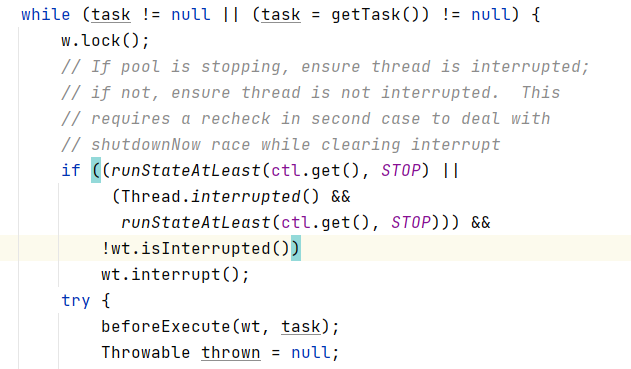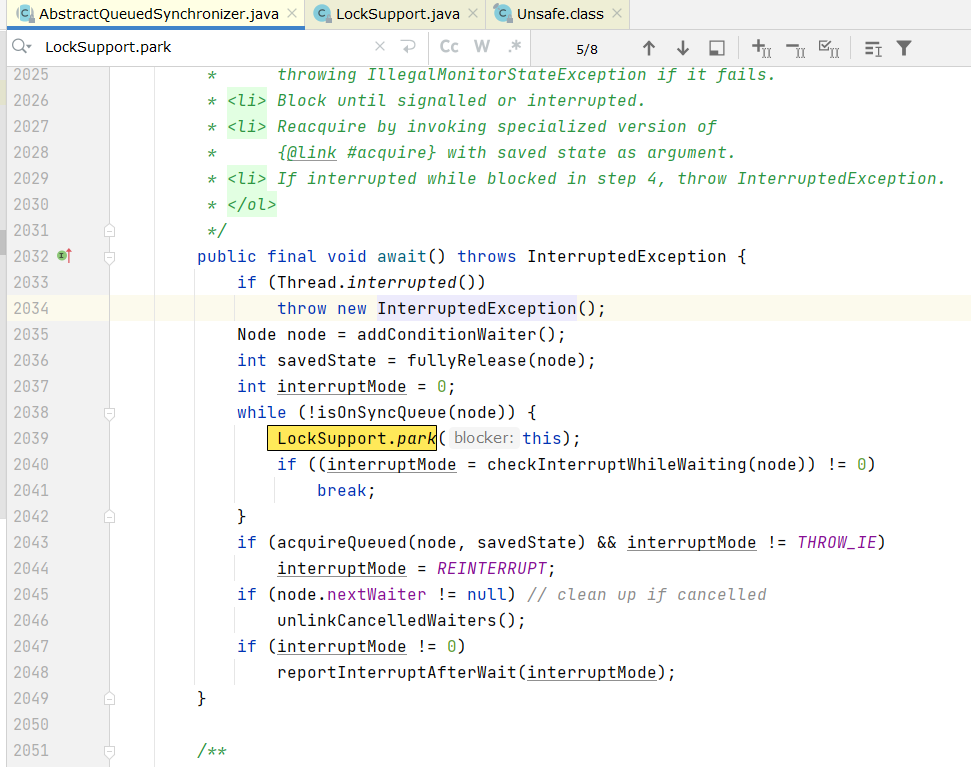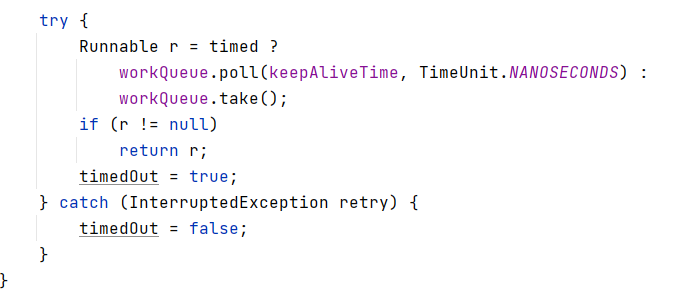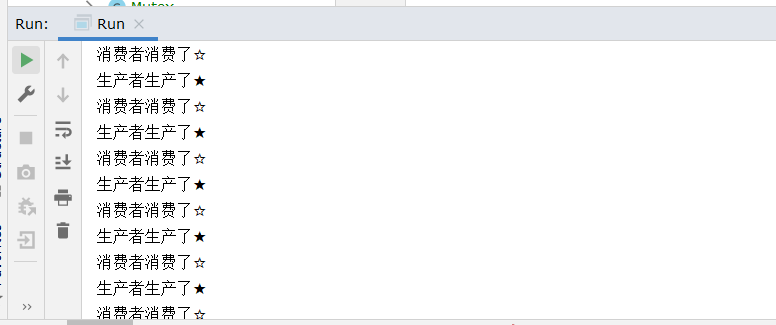Java多线程编程技术实践
最近笔者面试的时候被面试官问到了有关Java线程池源码方面的问题,没有回答上来,所以准备好好研究一下Java线程池底层源码。当我打开JDK源码的时候,我整个人就愣住了,像极了刘姥姥进大观园,Java线程池源码中的一些涉及到多线程相关的API,我竟然已经完全忘记了这些方法的作用,于是便准备总结一篇Java多线程编程技术相关的内容,用以对自己所学知识的总结。
本文会总结常见的Java多线程基础练习和面试题,包括《Java多线程编程核心技术》、《Java并发编程的艺术》上的Code,以及常见的多线程笔试面试题。
基础
Java线程状态变迁
这里笔者给出Java线程状态变迁一览图,之后提到的线程状态可在此查阅

- NEW
- RUNNABLE
- WAITING
- TIMED_WATING
- BLOCKED
- TERMINATED
Object类方法
wait()
调用该方法之后,当前线程会释放掉锁并且进入waiting状态。
notify()
该方法用来唤醒处于waiting状态的线程,调用了该方法之后,不会直接释放锁并唤醒线程,而是会等该线程将同步代码块执行完之后,也就是退出了syanchronized同步区域后,才会释放锁。
总结
这两个方法是多线程编程技术中最基础的两个方法,使用这两个方法使需要注意,当调用某个对象的wait或者是notify方法前,该线程需要获得该线程的Synchronized锁,否则会出现IllegalMonitorStateException。
Thread类方法
sleep(Time)
调用该方法之后,该线程会进入TIMED_WAITING状态,经过固定的时间后继续运行。
interrupt()
通过调用一个线程的 interrupt() 方法来中断该线程,但是中断不一定会生效,仅仅只是将该线程标记为中断状态,可以通过**interrupted()**方法和 isInterrupted() 判断该线程是否处于中断状态。那么中断什么时候会立即生效呢,如果该线程处于Blocked、TIMED_WATING、WATING状态,那么就会抛出 InterruptedException,从而提前结束该线程。但是不能中断 I/O 阻塞和 synchronized 锁阻塞。
那如果是不处于这些阻塞等待状态的线程我们如何使它结束呢?那么就要使用以下两个方法了。
interrupted()
通过interrupted方法,可以判断当前线程是否处于中断状态,处于的话,返回True,否则返回False,通过该方法,我们可以在一个循环执行的线程中判断线程是否中断了,如果是,就可以通过提前Return或者 Throw InterruptedException来结束该线程
isInterrupted()
该方法和上述方法类似,两个方法的区别如下:
- interrupted()方法:执行后会清除掉状态标志值的功能,会重新设置为false
- isInterrupted()方法:执行完不会清除状态标志
Code Demo
class MyThread implements Runnable {
@Override
public void run() {
try {
while (true) {
System.out.println("线程一直在执行");
if (Thread.interrupted()) {
throw new InterruptedException();
}
}
}catch (InterruptedException e) {
Logger.getLogger(MyThread.class.getName()).info(Thread.currentThread().getName() + "线程结束了");
}
}
}
通过这种方式,线程就能被interrupt()方法中断
我们再看看线程池中关于这两个方法的应用,线程池在这方面的应用比较复杂,笔者目前也不是太清楚,之后会详细的阅读线程池源码,总结这一部分的知识。

//ThreadPoolExecutor.class
final void runWorker(Worker w) {
Thread wt = Thread.currentThread();
Runnable task = w.firstTask;
w.firstTask = null;
w.unlock(); // allow interrupts
boolean completedAbruptly = true;
try {
while (task != null || (task = getTask()) != null) {
w.lock();
// If pool is stopping, ensure thread is interrupted;
// if not, ensure thread is not interrupted. This
// requires a recheck in second case to deal with
// shutdownNow race while clearing interrupt
if ((runStateAtLeast(ctl.get(), STOP) ||
(Thread.interrupted() &&
runStateAtLeast(ctl.get(), STOP))) &&
!wt.isInterrupted())
wt.interrupt();
try {
beforeExecute(wt, task);
Throwable thrown = null;
try {
task.run();
} catch (RuntimeException x) {
thrown = x; throw x;
} catch (Error x) {
thrown = x; throw x;
} catch (Throwable x) {
thrown = x; throw new Error(x);
} finally {
afterExecute(task, thrown);
}
} finally {
task = null;
w.completedTasks++;
w.unlock();
}
}
completedAbruptly = false;
} finally {
processWorkerExit(w, completedAbruptly);
}
}
stop()方法
该方法可以直接暴力使线程停止,该方法会强行终止线程,所以如果使用该方法,可能会导致业务数据处理不一致的情况,所以该方法目前已经废弃了。而它的实现原理就是在调用该方法时会抛出ThreadDeath Error,从而使线程直接退出。
yield()
yield()方法的作用是放弃当前的CPU资源,让其他任务去占用CPU资源,调用该方法后,线程的状态还是RUNNABLE状态,但是会从RUNNING变成READY。
Lock类方法
Condition类
通过Condition类,我们也可以实现和 Synchronized + wait + notify 一样的Wait/Notify模型,并且还可以实现多路通知功能,也就是在一个Lock对象中可以创建对各Condition实例,线程对象注册在不同的Condition队列中,从而可以有选择性地进行线程通知,在调度线程上更加灵活。同样,与Synchronized一样,在调用Condition对象的方法前,也需要获取Lock锁,否则会出现IllegalMonitorStateException异常。
await()
执行该方法后,该线程会进入此condition队列中等待,相当于Object.await()方法。
sign()
执行该方法后,会唤醒一个condition队列中的线程,相当于Object.notify()方法。
Code Demo
public class ConditionUseCase {
Lock lock = new ReentrantLock();
Condition condition1 = lock.newCondition();
Condition condition2 = lock.newCondition();
public void conditionWait1() throws InterruptedException {
lock.lock();
try {
condition1.await();
} finally {
lock.unlock();
}
System.out.println("wait1执行完毕");
}
public void conditionSignal1() throws InterruptedException {
lock.lock();
try {
condition1.signal();
}finally {
lock.unlock();
}
System.out.println("sign1执行完毕");
}
public void conditionWait2() throws InterruptedException {
lock.lock();
try {
condition2.await();
} finally {
lock.unlock();
}
System.out.println("wait2执行完毕");
}
public void conditionSignal2() throws InterruptedException {
lock.lock();
try {
condition2.signal();
}finally {
lock.unlock();
}
System.out.println("sign2执行完毕");
}
}
此处condition1和condition2之间的操作就是独立的,condition2的sign()方法不会对condition1中的线程产生影响,同样,condition1也不会对condition2造成影响。
让我们来简单看一下await()方法的简单实现
//AQS.Condition
public final void await() throws InterruptedException {
//判断该线程是否被中断,如果被中断了,就抛出InterruptedException结束线程
if (Thread.interrupted())
throw new InterruptedException();
//添加到Condition队列
Node node = addConditionWaiter();
int savedState = fullyRelease(node);
int interruptMode = 0;
while (!isOnSyncQueue(node)) {
//调用LockSupport.park方法阻塞线程
LockSupport.park(this);
if ((interruptMode = checkInterruptWhileWaiting(node)) != 0)
break;
}
if (acquireQueued(node, savedState) && interruptMode != THROW_IE)
interruptMode = REINTERRUPT;
if (node.nextWaiter != null) // clean up if cancelled
unlinkCancelledWaiters();
if (interruptMode != 0)
reportInterruptAfterWait(interruptMode);
}
//LockSupport的park方法调用了UNSAFE类的park方法阻塞线程
public static void park(Object blocker) {
Thread t = Thread.currentThread();
setBlocker(t, blocker);
UNSAFE.park(false, 0L);
setBlocker(t, null);
}
LockSupport工具类
上文中发现源码中多次出现了LockSupport这个工具类,当需要阻塞和唤醒一个线程的时候,就会通过LockSupport()来完成相应的功能。LockSupport是JDK提供的一个并发工具类,它定义了一组公共静态方法,这些方法提供了最基本的线程阻塞和唤醒功能,而LockSupport也成为了构建同步组件的基础工具
它在JDK并发包中用到了多次,比如AQS中 Condition类的 await() 方法

park(Object blocker)
阻塞当前线程,blocker是用来标识当前线程阻塞的对象,该对象主要用于问题排查和系统监控。
parkNanos(Object blocker, long nanos)
阻塞当前线程,最长不超过nanos纳秒。
unpark(Thread thread)
唤醒处于阻塞状态的线程thread
阻塞队列
阻塞队列是一个支持阻塞的插入和移除元素的队列。
- 支持阻塞的插入方法:意思是当队列满时,队列会阻塞插入元素的线程,直到队列不满
- 支持阻塞的移除方法:意思是当队列为空时,获取元素的线程会等待队列变为非空
在阻塞队列不可用时,阻塞队列提供了四种不同的处理方式。

这里稍微介绍一下几个常用的方法。
take() 和 poll()
这两个方法都能从阻塞队列中获取元素,但是take会一直阻塞,而poll会在阻塞队列为空时返回null。
通过这样的特性,我们可以实现不同的线程针对阻塞队列有不同的操作,比如线程池中从任务队列中获取任务。

boolean timed = allowCoreThreadTimeOut || wc > corePoolSize;
try {
//timed表示此时该线程是核心线程还是临时线程
Runnable r = timed ?
//临时线程就调用poll,设定超时时间为keepAliveTime,临时线程存活时间
workQueue.poll(keepAliveTime, TimeUnit.NANOSECONDS) :
//核心线程就调用take,会一直阻塞的等待阻塞队列不为空然后返回一个任务
workQueue.take();
if (r != null)
return r;
//设置timedOut为true,这个Worker就会进入之后的销毁逻辑
timedOut = true;
} catch (InterruptedException retry) {
timedOut = false;
}
put() 和 offer()
put和offer都会往阻塞队列里添加任务,但是put会阻塞,offer不会阻塞。
Java里的阻塞队列
- ArrayBlockingQueue:一个由数组结构组成的有界阻塞队列
- LinkedBlockingQueue:一个由链表结构组成的有界阻塞队列
- PriorityBlockingQueue:一个支持优先级排序的无界阻塞队列
- DelayQueue:一个使用优先级队列实现的无界阻塞队列
- SynchronousQueue:一个不存储元素的阻塞队列
- LinkedTransferQueue:一个由链表结构组成的无界阻塞队列
- LinkedBlockingDeque:一个由链表结构组成的双向阻塞队列
由于笔者对于阻塞队列了解的不是很深入,在此处便不再赘述,之后我会在练习篇给读者手写一个最为常用的阻塞队列ArrayBlockingQueue
Fork/Join
Fork/Join框架是Java7提供的一个用于进行并行执行任务的框架,是一个把大任务分割成若干个小任务,最终汇总每个小人物结果后得到大任务结果的框架。
工作窃取算法
工作窃取算法是指某个线程从其他队列里窃取任务来执行。它可以提高程序并行执行的效率,由于各个工作线程的效率不同,可能会出现A线程已经干完了自己的活,B线程还有很多活没干的情况。如果此时A线程不工作了的话,那么A线程的工作能力就浪费了,于是A线程会窃取B线程的任务,这样就保证了工作的效率。但是因为有多个线程同时访问一个任务队列,为了避免冲突,于是可以使用双端队列,被窃取任务的线程永远从双端队列的头部拿任务执行,而窃取任务的线程永远从双端队列的尾部拿任务执行。
大体思路:
- 每个线程都有自己的一个WorkQueue,该工作队列是一个双端队列。
- 队列支持三个功能push、pop、poll
- push和poll针对队列尾部,pop针对队列头部
- push/pop只能被队列的所有者线程调用,而poll可以被其他线程调用。
- 划分的子任务调用fork时,都会被push到自己的队列中。
- 默认情况下,工作线程从自己的双端队列头部执行pop方法获出任务并执行。
- 当自己的队列为空时,线程随机从另一个线程的队列末尾调用poll方法窃取任务。
使用
Fork/Join使用两个类来完成任务的分割以及结果的合并。
- ForkJoinTask:它提供在任务中执行fork() 和 join() 操作的机制。通常情况下,我们不需要直接继承ForkJoinTask类,只需要继承它的子类。
- RecursiveAction:用于没有返回结果的任务
- RecursiveTask:用于有返回结果的任务
- ForkJoinPool:ForkJoinTask需要通过ForkJoinPool来执行
Code Demo
import java.util.concurrent.*;
/**
* 需求:使用Java多线程计算 1+2+3+4的结果
*/
public class CountTask extends RecursiveTask<Integer> {
private static final int THRESHOLD = 2;//阈值
private int start;
private int end;
public CountTask(int start, int end) {
this.start = start;
this.end = end;
}
@Override
protected Integer compute() {
int sum = 0;
//如果任务足够小就计算任务 fork 边界
boolean canCompute = (end - start) <= THRESHOLD;
if(canCompute) {
for(int i = start; i <= end ;i++) {
sum+=i;
}
} else {
//任务 fork
int mid = (start + end) / 2;
CountTask leftTask = new CountTask(start,mid);
CountTask rightTask = new CountTask(mid + 1, end);
//执行子任务
leftTask.fork();
rightTask.fork();
int leftRes = leftTask.join();
int rightRes = rightTask.join();
sum = leftRes + rightRes;
}
return sum;
}
public static void main(String[] args) {
ForkJoinPool forkJoinPool = new ForkJoinPool();
CountTask task = new CountTask(1,4);
//通过ForkJoinPool来执行ForkJoinTask
Future<Integer> result = forkJoinPool.submit(task);
Throwable exception = task.getException();
System.out.println(exception);
try {
System.out.println(result.get());
} catch (InterruptedException e) {
} catch (ExecutionException e) {
}
}
}
原子类
原子类又被称为轻量级的线程安全实现机制,通过原子类的API,我们能避免多线程情况下的三大并发问题发生,分别是有序性,可见性,原子性,并且原子类底层并没有使用锁机制来实现,而是通过Unsafe类的CAS方法,实现的乐观锁机制,原子类保证保证原子类的值被更新都是线程安全的,不会出现并发问题。
比如AtomicInteger类的API,通过这些API操作对象,就可以保证多线程的线程安全
public final int get():获取当前的值
public final int getAndSet(int newValue):获取当前的值,并设置新的值
public final int getAndIncrement():获取当前的值,并自增
public final int getAndDecrement():获取当前的值,并自减
public final int getAndAdd(int delta):获取当前的值,并加上预期的值
void lazySet(int newValue): 最终会设置成newValue,使用lazySet设置值后,可能导致其他线程在之后的一小段时间内还是可以读到旧的值。
比如如果想在单机实现一个点赞,秒杀系统,我们就可以利用原子类的特性,通过操作原子类来添加点赞(扣减库存)。
那我们来看一下原子类底层是如何实现的
//AtomicInteger.class
public final int getAndIncrement() {
return unsafe.getAndAddInt(this, valueOffset, 1);
}
public final int getAndDecrement() {
return unsafe.getAndAddInt(this, valueOffset, -1);
}
public final int getAndAdd(int delta) {
return unsafe.getAndAddInt(this, valueOffset, delta);
}
public final int incrementAndGet() {
return unsafe.getAndAddInt(this, valueOffset, 1) + 1;
}
public final int decrementAndGet() {
return unsafe.getAndAddInt(this, valueOffset, -1) - 1;
}
public final int addAndGet(int delta) {
return unsafe.getAndAddInt(this, valueOffset, delta) + delta;
}
我们可以发现,AtomicInteger的方法基本上都是通过unsafe类的方法实现的,那让我们接着看一下unsafe类的代码
//Unsafe.class
public final int getAndAddInt(Object paramObject, long paramLong, int paramInt)
{
int i;
do
i = getIntVolatile(paramObject, paramLong);
while (!compareAndSwapInt(paramObject, paramLong, i, i + paramInt));
return i;
}
public final long getAndAddLong(Object paramObject, long paramLong1, long paramLong2)
{
long l;
do
l = getLongVolatile(paramObject, paramLong1);
while (!compareAndSwapLong(paramObject, paramLong1, l, l + paramLong2));
return l;
}
public final int getAndSetInt(Object paramObject, long paramLong, int paramInt)
{
int i;
do
i = getIntVolatile(paramObject, paramLong);
while (!compareAndSwapInt(paramObject, paramLong, i, paramInt));
return i;
}
public final long getAndSetLong(Object paramObject, long paramLong1, long paramLong2)
{
long l;
do
l = getLongVolatile(paramObject, paramLong1);
while (!compareAndSwapLong(paramObject, paramLong1, l, paramLong2));
return l;
}
public final Object getAndSetObject(Object paramObject1, long paramLong, Object paramObject2)
{
Object localObject;
do
localObject = getObjectVolatile(paramObject1, paramLong);
while (!compareAndSwapObject(paramObject1, paramLong, localObject, paramObject2));
return localObject;
}
从源码中发现,内部使用自旋的方式进行CAS更新(while循环进行CAS更新,如果更新失败,则循环再次重试)。
又从Unsafe类中发现,CAS操作其实只支持下面三个方法。
public final native boolean compareAndSwapObject(Object paramObject1, long paramLong, Object paramObject2, Object paramObject3);
public final native boolean compareAndSwapInt(Object paramObject, long paramLong, int paramInt1, int paramInt2);
public final native boolean compareAndSwapLong(Object paramObject, long paramLong1, long paramLong2, long paramLong3);
分别是三个Native方法,针对Object,Int,Long三种类型变量的操作。
不妨再看看Unsafe的compareAndSwap方法来实现CAS操作,它是一个本地方法,实现位于unsafe.cpp中。
UNSAFE_ENTRY(jboolean, Unsafe_CompareAndSwapInt(JNIEnv *env, jobject unsafe, jobject obj, jlong offset, jint e, jint x))
UnsafeWrapper("Unsafe_CompareAndSwapInt");
oop p = JNIHandles::resolve(obj);
jint* addr = (jint *) index_oop_from_field_offset_long(p, offset);
return (jint)(Atomic::cmpxchg(x, addr, e)) == e;
UNSAFE_END
可以看到它通过 Atomic::cmpxchg 来实现比较和替换操作。其中参数x是即将更新的值,参数e是原内存的值。
如果是Linux的x86,Atomic::cmpxchg方法的实现如下:
inline jint Atomic::cmpxchg (jint exchange_value, volatile jint* dest, jint compare_value) {
int mp = os::is_MP();
__asm__ volatile (LOCK_IF_MP(%4) "cmpxchgl %1,(%3)"
: "=a" (exchange_value)
: "r" (exchange_value), "a" (compare_value), "r" (dest), "r" (mp)
: "cc", "memory");
return exchange_value;
}
所以说Unsafe类的compareAndSwap方法就是通过Linux的一条汇编指令 cmpxchg原子指令来实现的。
等待多线程完成的CountDownLatch
CountDownLatch允许一个或多个线程等待其他线程完成操作。
比如我们有一个需求,需要解析一个Excel里多个sheet的数据,此时完全可以用多线程执行操作,每个线程解析一个sheet里的数据,等到所有的sheet都解析完之后,程序需要提示解析完成。在这个需求中,要实现主线程等待所有线程完成sheet的解析操作,我们就可以使用CountDownLatch让主线程等待其他线程执行完成。
/**
* 需求:实现一个线程等待多个线程执行完成之后再执行
* 方法1:使用Thread类的Join方法
* 方法2:使用CountDownLatch类
*/
public class CountDownLatchTest {
private static final int N = 2;
static CountDownLatch c = new CountDownLatch(N);
public static void main(String[] args) throws InterruptedException {
new Thread(() -> {
System.out.println(1);
c.countDown();
}).start();
new Thread(() -> {
System.out.println(2);
c.countDown();
}).start();
c.await();
System.out.println(3);
}
}
c.await()方法会阻塞当前线程,直到N减到0。由于c.countDown()可以用在任何地方,所以我们也可以在一个线程的多个步骤里执行该方法。此处CountDownLatch是一个静态变量,如果不想用静态变量的话,只需要将CountDownLatch变量通过构造方法传进线程即可。
同步屏障CyclicBarrier
让一组线程到达一个屏障时被阻塞,直到所有线程到达屏障的时候,屏障才会开门,所有被屏障拦截的线程才会继续运行。
public class CyclicBarrierTest {
static CyclicBarrier c = new CyclicBarrier(2);
public static void main(String[] args) {
new Thread(() -> {
try {
c.await();
} catch (InterruptedException e) {
} catch (BrokenBarrierException e) {
}
System.out.println(1);
}).start();
try {
c.await();
} catch (InterruptedException e) {
e.printStackTrace();
} catch (BrokenBarrierException e) {
e.printStackTrace();
}
System.out.println(2);
}
}
我们可以比较一下CountDownLatch和CyclicBarrier的区别,
- 它们内部都有一个N,不同的是CountDownLatch不需要阻塞一个线程就可以让N减一,但是CyclicBarrier必须要一个线程调用await方法阻塞后N才能减一。
- CountDownLatch的计数器只能使用一次,而CyclicBarrier的计数器可以使用reset()方法重置计数器,所以CyclicBarrier适合更加复杂的场景。
CyclicBarrier可以用于多线程计算数据,最后合并计算结果的场景,例如,用一个Excel保存了用户所有银行流水,每个Sheet保存一个账户近一年的每笔银行流水,现在需要统计用户的日均银行流水,先用多线程处理每个sheet里的银行流水,都执行完之后,得到每个sheet的日均银行流水,最后,再用barrierAction用这些线程的计算结果,计算出整个Excel的日均银行流水。
Semaphore
Semaphore信号量是用来控制同时访问特定资源的线程数量,它通过协调各个线程,以保证合理的使用公共资源。
学过操作系统的信号量的话,就能很轻松的明白信号量的含义了
/**
* 需求:限制只有N个线程可以获取资源,其他的线程会阻塞
*/
public class SemaphoreTest {
private static final int THREAD_COUNT = 30;
private static ExecutorService threadPool = Executors.newFixedThreadPool(THREAD_COUNT);
private static Semaphore s = new Semaphore(10);
public static void main(String[] args) {
for(int i = 0 ; i < THREAD_COUNT ;i++) {
threadPool.execute( () -> {
try {
s.acquire();
System.out.println("save Date");
s.release();
} catch (InterruptedException e) {
e.printStackTrace();
}
});
}
threadPool.shutdown();
}
}
acquire方法类似操作系统信号量的P操作
release方法类似操作系统信号量的V操作
线程间交换数据的Exchanger
Exchanger是一个用来线程间协作的工具类。Exchanger用于进行线程间的数据交换。它提供一个同步点,在这个同步点,两个线程可以交换彼此的数据。这两个线程通过exchange方法,当两个线程都到达同步点时,这两个线程就可以交换数据,将本线程生产出来的数据传递给对方。
/**
* 场景:线程间交换数据
* 需求:校对两个人的工作结果是否一致
*/
public class ExchangerTest {
//交换器
private static final Exchanger<String> EXCHANGER = new Exchanger<String>();
//线程池
private static ExecutorService threadPool = Executors.newFixedThreadPool(2);
public static void main(String[] args) {
threadPool.execute(() -> {
String A = "银行流水A";
try {
//到达同步点
String B = EXCHANGER.exchange(A);
System.out.println(B);
} catch (InterruptedException e) {
e.printStackTrace();
}
});
threadPool.execute(() -> {
String B = "银行流水B";
try {
//到达同步点
String A = EXCHANGER.exchange(B);
System.out.println(A);
} catch (InterruptedException e) {
e.printStackTrace();
}
});
threadPool.shutdown();
}
}
如果两个线程有一个没有执行exchange方法,则会一直等待,如果担心特殊情况发生,可以使用
exchange(V x, long timeout, TimeUnit unit)
练习
1114. 按序打印
给你一个类:
public class Foo {
public void first() { print("first"); }
public void second() { print("second"); }
public void third() { print("third"); }
}
三个不同的线程 A、B、C 将会共用一个 Foo 实例。
线程 A 将会调用 first() 方法
线程 B 将会调用 second() 方法
线程 C 将会调用 third() 方法
请设计修改程序,以确保 second() 方法在 first() 方法之后被执行,third() 方法在 second() 方法之后被执行。
提示:
尽管输入中的数字似乎暗示了顺序,但是我们并不保证线程在操作系统中的调度顺序。
你看到的输入格式主要是为了确保测试的全面性。
示例 1:
输入:nums = [1,2,3]
输出:“firstsecondthird”
解释:
有三个线程会被异步启动。输入 [1,2,3] 表示线程 A 将会调用 first() 方法,线程 B 将会调用 second() 方法,线程 C 将会调用 third() 方法。正确的输出是 “firstsecondthird”。
示例 2:
输入:nums = [1,3,2]
输出:“firstsecondthird”
解释:
输入 [1,3,2] 表示线程 A 将会调用 first() 方法,线程 B 将会调用 third() 方法,线程 C 将会调用 second() 方法。正确的输出是 “firstsecondthird”。
题解:
/*
* 通过信号量实现
* 针对second 和 third 都设置一个信号量资源,从而实现线程等待的情况
*/
class Foo {
Semaphore semaphoreTwo ;
Semaphore semaphoreThree;
public Foo() {
semaphoreTwo = new Semaphore(0);
semaphoreThree = new Semaphore(0);
}
public void first(Runnable printFirst) throws InterruptedException {
// printFirst.run() outputs "first". Do not change or remove this line.
printFirst.run();
semaphoreTwo.release();
}
public void second(Runnable printSecond) throws InterruptedException {
semaphoreTwo.acquire();
// printSecond.run() outputs "second". Do not change or remove this line.
printSecond.run();
semaphoreThree.release();
}
public void third(Runnable printThird) throws InterruptedException {
semaphoreThree.acquire();
// printThird.run() outputs "third". Do not change or remove this line.
printThird.run();
}
}
/**
* 通过Synchronized实现
* 通过一个变量的值来实现
* 类似生产者消费者模型
*/
class Foo {
int x = 1;
public Foo() {
}
public void first(Runnable printFirst) throws InterruptedException {
synchronized (Foo.class) {
// printFirst.run() outputs "first". Do not change or remove this line.
printFirst.run();
x = 2;
Foo.class.notifyAll();
}
}
public void second(Runnable printSecond) throws InterruptedException {
synchronized (Foo.class) {
while (x != 2) {
Foo.class.wait();
}
// printSecond.run() outputs "second". Do not change or remove this line.
printSecond.run();
x = 3;
Foo.class.notifyAll();
}
}
public void third(Runnable printThird) throws InterruptedException {
synchronized (Foo.class) {
// printThird.run() outputs "third". Do not change or remove this line.
while (x != 3) {
Foo.class.wait();
}
printThird.run();
}
}
}
1115. 交替打印 FooBar
给你一个类:
class FooBar {
public void foo() {
for (int i = 0; i < n; i++) {
print("foo");
}
}
public void bar() {
for (int i = 0; i < n; i++) {
print("bar");
}
}
}
两个不同的线程将会共用一个 FooBar 实例:
- 线程 A 将会调用 foo() 方法
- 线程 B 将会调用 bar() 方法
请设计修改程序,以确保 “foobar” 被输出 n 次。
示例 1:
输入:n = 1
输出:“foobar”
解释:这里有两个线程被异步启动。其中一个调用 foo() 方法, 另一个调用 bar() 方法,“foobar” 将被输出一次。
示例 2:
输入:n = 2
输出:“foobarfoobar”
解释:“foobar” 将被输出两次。
分析:典型的盘子容量为1的生产者消费者模型,
- 可以通过synchronized等待唤醒大法实现
- 可以通过Semaphore信号量实现
题解:
//synchronized 等待唤醒大法
class FooBar {
private int n;
//顺序为1,foo输出
//顺序为2,bar输出
int shunxu = 1;
Object lock = new Object();
public FooBar(int n) {
this.n = n;
}
public void foo(Runnable printFoo) throws InterruptedException {
for (int i = 0; i < n; i++) {
synchronized (lock) {
// printFoo.run() outputs "foo". Do not change or remove this line.
while (shunxu != 1) lock.wait();
printFoo.run();
shunxu = 2;
lock.notifyAll();
}
}
}
public void bar(Runnable printBar) throws InterruptedException {
for (int i = 0; i < n; i++) {
synchronized (lock) {
// printBar.run() outputs "bar". Do not change or remove this line.
while (shunxu != 2) lock.wait();
printBar.run();
shunxu = 1;
lock.notifyAll();
}
}
}
}
//Semaphore信号量实现
class FooBar {
private int n;
Semaphore semaphore1 = new Semaphore(1);
Semaphore semaphore2 = new Semaphore(0);
public FooBar(int n) {
this.n = n;
}
public void foo(Runnable printFoo) throws InterruptedException {
for (int i = 0; i < n; i++) {
semaphore1.acquire();
// printFoo.run() outputs "foo". Do not change or remove this line.
printFoo.run();
semaphore2.release();
}
}
public void bar(Runnable printBar) throws InterruptedException {
for (int i = 0; i < n; i++) {
semaphore2.acquire();
// printBar.run() outputs "bar". Do not change or remove this line.
printBar.run();
semaphore1.release();
}
}
}
手写生产者消费者模式——多生产者多消费者
注意:写生产者消费者模式有两个注意点
- 线程阻塞的判断条件尽量用While判断(防止多生产者多消费者的时候错误唤醒)
- 使用两个Condition队列代表生产者阻塞线程队列和消费者阻塞线程队列
//MyService.class
//业务类
public class MyService {
private Lock lock = new ReentrantLock();
private Condition producerCondition = lock.newCondition();
private Condition consumerCondition = lock.newCondition();
private boolean hasValue = false;
public void set() {
try {
lock.lock();
while (hasValue == true) {
producerCondition.await();
}
System.out.println("生产者生产了★");
hasValue = true;
consumerCondition.signalAll();
} catch (InterruptedException e) {
e.printStackTrace();
} finally {
lock.unlock();
}
}
public void get() {
try {
lock.lock();
while (hasValue == false) {
consumerCondition.await();
}
System.out.println("消费者消费了☆");
hasValue = false;
producerCondition.signalAll();
} catch (InterruptedException e) {
e.printStackTrace();
} finally {
lock.unlock();
}
}
}
//Run.class
//启动10个生产和消费者线程
public class Run {
public static void main(String[] args) throws InterruptedException {
MyService service = new MyService();
for (int i = 0; i < 10; i++) {
new Thread(() -> {
while (true)
service.set();
}).start();
new Thread(() -> {
while (true)
service.get();
}).start();
}
}
}
运行结果

实现一个简单的BlockingQueue
思路:我们知道,阻塞队列就是一个天然的生产者消费者模型,那我们就可以用相同的思路来实现。
take方法:如果队列已经空了,那就阻塞线程,取出来一个对象之后就唤醒所有线程
put方法:如果队列已经满了,那就阻塞线程,添加进去一个对象之后就唤醒所有线程
注意:通过数组实现队列,还隐含了一个用数组实现循环队列的思路
/**
* take方法:如果队列已经空了,那就阻塞线程,取出来一个对象之后就唤醒所有线程
*
* put方法:如果队列已经满了,那就阻塞线程,添加进去一个对象之后就唤醒所有线程
*
* 注意:通过数组实现队列,还隐含了一个用数组实现循环队列的思路
*/
public class BoundedQueue <T>{
private Object [] items;
private Lock lock = new ReentrantLock();
private int capacity;
private int size = 0;
/**
* 用数组实现的队列,需要保存队头和队尾的下标
*/
private int head , tail;
/**
* 由于队列满了阻塞的生产者线程
*/
private Condition fullCondition = lock.newCondition();
/**
* 由于队列空了阻塞的消费者线程
*/
private Condition emptyCondition = lock.newCondition();
public BoundedQueue(int capacity) {
this.capacity = capacity;
items = new Object[capacity];
}
public void put(T t) {
lock.lock();
try {
while (size == capacity) {
fullCondition.await();
}
items[head] = t;
//循环添加到数组中
if(++head == capacity) {
head = 0;
}
++size;
emptyCondition.signalAll();
} catch (InterruptedException e) {
e.printStackTrace();
} finally {
lock.unlock();
}
}
@SuppressWarnings("unchecked")
public T take() {
lock.lock();
try {
while (size == 0) {
emptyCondition.await();
}
Object x = items[tail];
if(++tail == capacity) {
tail = 0;
}
--size;
fullCondition.signalAll();
return (T) x;
} catch (InterruptedException e) {
e.printStackTrace();
} finally {
lock.unlock();
}
return null;
}
}
单元测试(希望广大程序员养成单元测试的好习惯)
public class BoundedQueueTest {
@Test
public void putTest() {
BoundedQueue<Integer> queue = new BoundedQueue<>(1);
queue.put(1);
System.out.println("1 put success");
queue.put(2);
System.out.println("2 put success");
}
@Test
public void takeTest() {
BoundedQueue<Integer> queue = new BoundedQueue<>(1);
queue.put(1);
System.out.println("1 put success");
queue.take();
System.out.println("1 take success");
queue.take();
System.out.println("take success");
}
}
执行结果


可以发现,阻塞队列的API成功阻塞了。
循环顺序打印ABC
题目:使用三个线程,A线程打印A,B线程打印B,C线程打印C,循环打印ABC十次。
/**
* 顺序打印ABC
* 循环十次
*/
public class ABC {
private final static int N = 10;
/**
* 1:A执行
* 2:B执行
* 3:C执行
*/
private int shunxun = 1;
private Object lock = new Object();
class A extends Thread {
@Override
public void run() {
synchronized (lock) {
for (int i = 0; i < N; i++) {
while (shunxun != 1) {
try {
lock.wait();
} catch (InterruptedException e) {
e.printStackTrace();
}
}
System.out.println("A");
shunxun = 2;
lock.notifyAll();
}
}
System.out.println("A执行完");
}
}
class B extends Thread {
@Override
public void run() {
synchronized (lock) {
for (int i = 0; i < N; i++) {
while (shunxun != 2) {
try {
lock.wait();
} catch (InterruptedException e) {
e.printStackTrace();
}
}
System.out.println("B");
shunxun = 3;
lock.notifyAll();
}
}
System.out.println("B执行完");
}
}
class C extends Thread {
@Override
public void run() {
synchronized (lock) {
for (int i = 0; i < N; i++) {
while (shunxun != 3) {
try {
lock.wait();
} catch (InterruptedException e) {
e.printStackTrace();
}
}
System.out.println("C");
shunxun = 1;
lock.notifyAll();
}
}
System.out.println("C执行完");
}
}
@Test
public void test() throws InterruptedException {
new A().start();
new B().start();
new C().start();
Thread.sleep(1000);
}
}
输出结果
A
B
C
... × 10
A
B
A执行完
B执行完
C
C执行完





















 355
355











 被折叠的 条评论
为什么被折叠?
被折叠的 条评论
为什么被折叠?








